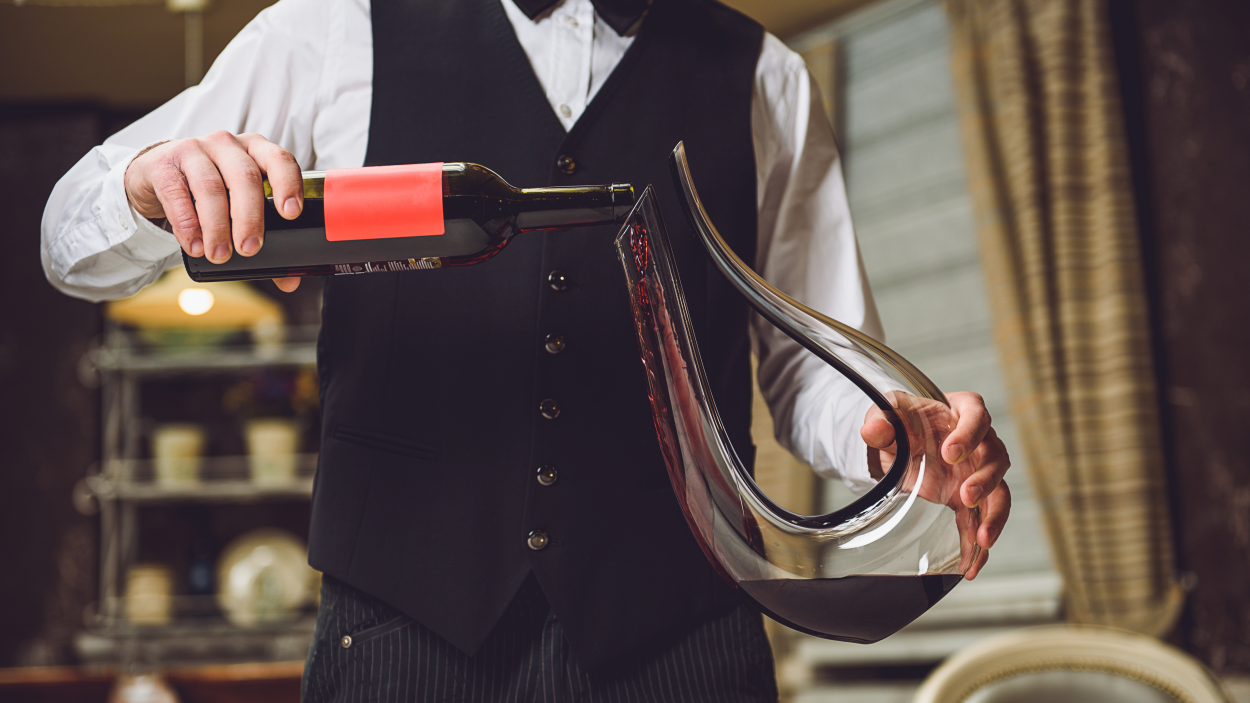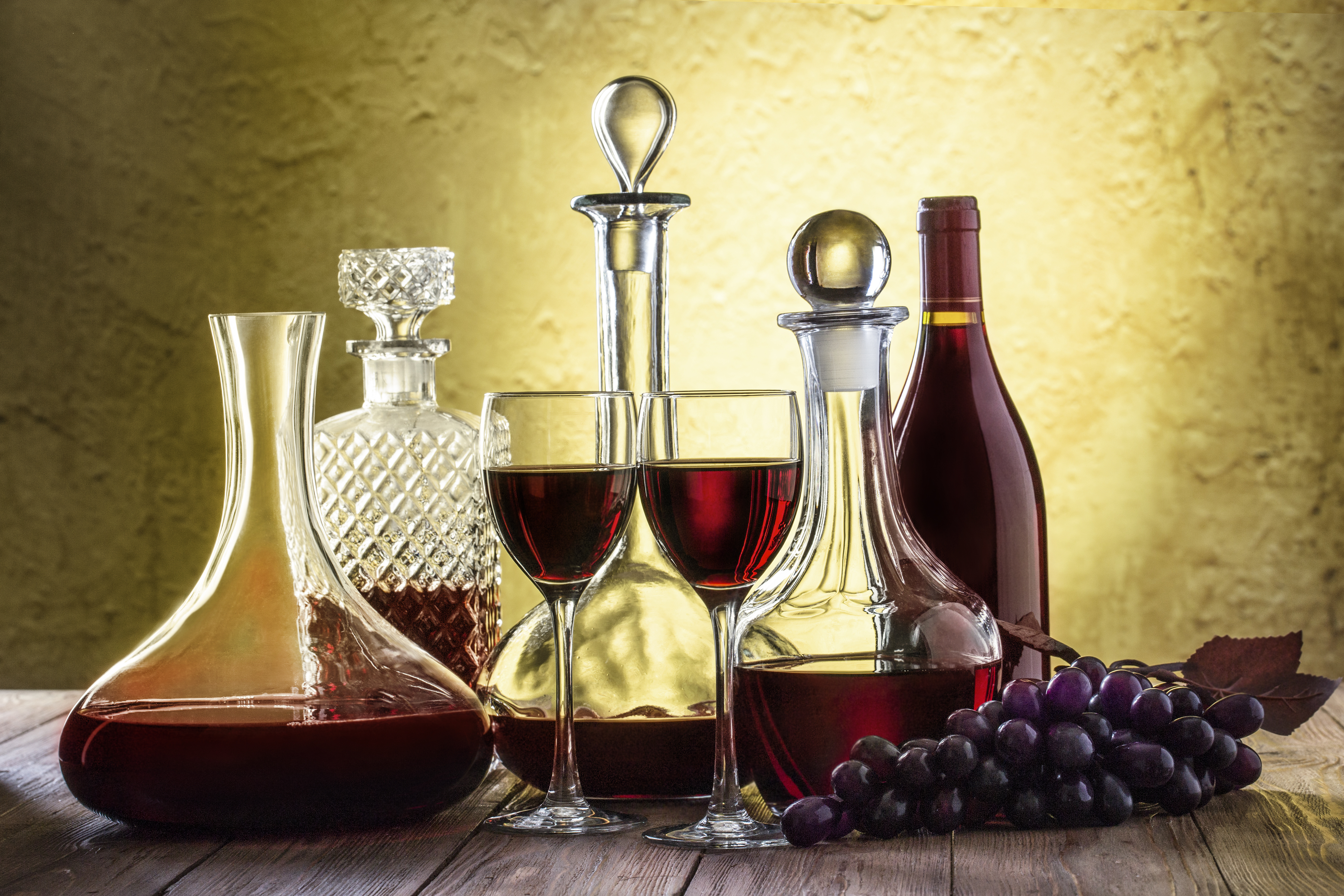
The Ultimate Guide to Decanting Wine
Learn how to decant wine, why we think it's a good idea, and how to do it
We've said before that wine is a living thing. It changes as it sits in the bottle, but sometimes even a good wine needs a little time to breathe before enjoying it. In long-term aging, oxygen is the enemy, but when you open a wine you want it to breathe to open up and express all the nuance it can.
On a small level, this is why we swirl wine in the glass. Through the process of aeration we are able to rapidly add oxygen to wine to release aromas. For a larger dose of whimsy and a little extra oxygen, many wine lovers choose to decant a wine. Many believe that decanted wine allows for a better wine tasting experience as well.
What is a decanter? A decanter is a vessel that is used to store and serve wine after it is removed from the bottle. For a young, tight wine, it is a useful way to rapidly aerate the liquids, and for older wines there is the added benefit of trapping any sediment (tannins and other compounds that settle out in a wine over time) that has resulted from the aging process. Knowing how to decant wine is a great technique every wine enthusiast should know as it improves the quality and flavor of wine over time, and you don't have to be a wine expert to begin experimenting with decanting.
Why Decant Wine?
Some people write off wine decanting as a bit pompous, strictly speaking, it's not necessary for most wines, but we love doing it. Wine is as much about romance as it is about science and art. There are plenty of guides claiming to know exactly when and what to decant, but if you enjoy the process we think you should use a decanter regardless.
Decanting wine will most noticeably help young, tight wines that need to loosen up a little bit (think California Cabernet or Merlot). Winemaking in and of itself is a fairly arduous process for the wine. Once the winemakers have the fermented wine it goes to a processing line and is shaken and forced into a small bottle before being shipped and eventually stored. When you open a bottle this is the first chance the wine has had to settle down since being put into the glass. In a decanter, you can see the color clearly and see how the wine develops after being opened. It's a beautiful process.
Another reason to use a decanter is to filter out sediment from old bottles of red wine. This process, which we will discuss more fully below, will help you make sure you don't have any bitter or astringent sediment in your wine glass.
History of Decanting Wine
We can thank the ancient Romans for using the first decanting vessel. As a wine-loving society, they not only spread grapes across their empire, but they were the first to show a strong preference for aged and mature wine and had strict serving etiquette. After the fall of the empire, their metal and glass decanters were lost to time until the Venetians improved on their glass blowing process over 1,000 years later.
These Venetian glass blowers discovered new processes and began making ornate serving vessels that made their way to Europe and beyond through trade routes. These drinking vessels were embellished with gold, silver, and bronze decorative elements and had fine etchings.
Eventually, stoppers were added. While the forms have changed the overall designs have remained fairly similar. Silver carafes may have given way to crystal, but we still enjoy drinking and pouring wine with our friends and family.

Find a New Red Wine and Start Experimenting with Decanting Today
Whether you’re looking to get started with decanting wine or have years of experience, we have the perfect red wine for you in our wine store. Shop red wines by region, varietal, and more.
SHOP red WINES NOw
The Science of Decanting Wine
The most important reason to use a decanter, other than aesthetic enjoyment, is to remove sediment from an older wine. As red wine ages, the tannins combine with other chemical compounds in the wine and polymerize, falling out to the bottom of a bottle. The aged wine invokes less astringent and bitter flavors, with more balanced and complex aromas. The leftover sediment is unpleasant, and decanting will allow you to remove the wine and leave the sediment.
Aeration is the second most important reason to decant and is all about how much surface area of a wine can be exposed to oxygen. This has led some manufacturers to create wine aerators that can be used when pouring from a bottle or decanters with especially wide bases to maximize air exposure in the decanter.
The Science of Decanting Wine
The most important reason to use a decanter, other than aesthetic enjoyment, is to remove sediment from an older wine. As red wine ages, the tannins combine with other chemical compounds in the wine and polymerize, falling out to the bottom of a bottle. The aged wine invokes less astringent and bitter flavors, with more balanced and complex aromas. The leftover sediment is unpleasant, and decanting will allow you to remove the wine and leave the sediment.
Aeration is the second most important reason to decant and is all about how much surface area of a wine can be exposed to oxygen. This has led some manufacturers to create wine aerators that can be used when pouring from a bottle or decanters with especially wide bases to maximize air exposure in the decanter.
How to Decant Wine
The first step in decanting is assessing the type of wine you have. If you have a young wine you can go ahead and open the bottle. If you have an old wine with sediment it is important to let it stand upright for around 24 hours to allow the sediment to settle to the bottom of the bottle.
When your wine bottle is open, you can begin very slowly pouring the wine into the decanter. If you have lots of old wine there are tools you can use (decanter cradles or decanting machines) that will be incredibly controlled, but this is generally not necessary even if you are pouring old wine. If there is sediment present shine a bright light source on the neck of the bottle as you pour and watch for any signs of sediment. As soon as you see any sediment come into the decanter stop pouring.
Once your wine is in the decanter you are ready to move to the next step, either serving or allowing it to settle for a little while. Tasting a wine through the process is the best way to know what you like, and is always a good way to see how a wine progresses through different stages of exposure to oxygen.
Controversies In Decanting Wine
As we briefly mentioned above, decanting is not usually a necessary step, but it is one that adds to the sensory experience of drinking wine. Decanting is also not without its critics and controversies that have provided wine lovers with a subject to debate at dinner parties for decades.
The science around aerating wine is divided, and not everyone believes it releases more aromas. Some believe it makes the few that are present dissipate more quickly.
Another contentious topic is what wines should and should not be decanted. Many believe that older Pinot Noir is too delicate to decant, but some vehemently disagree. The best way to find out who is right is to try it yourself!
Recently there have been more and more sommeliers in coastal cities like New York and San Francisco serving certain Champagnes in decanters, which can come as a shock if the waiter returns without a wine bottle. That being said, some richer styles are better after being decanted.
As with most debated subjects in wine, what really matters is your opinion. Drink wine how you like it.
Popular Decanters
So are you interested in finding out what the best wine decanter is? The only thing you really need is a carafe with high shoulders that will catch any potential sediment that might have fallen into the decanter. When looking for high-quality glassware (wine glasses or decanters) the first decision you will need to make is if you want glass, crystal, or lead-free crystal glass (which is a hybrid of the two, and not true crystal).
The biggest difference in these options is that glass will be thicker and (probably) dishwasher safe, whereas crystal is much more delicate, usually vintage, and should be hand washed.
Many reputable brands that make glass and lead-free crystal are available at varying price points, and you should look and see what makes the most sense to you.
Regardless you can find an affordable decanter online very easily. Some of the best affordable options include the Le Chateau wine decanter, the Menu Winebreather Carafe, and various styles from Sagaform, Godinger, or Vintorio.
If you would like to look at some higher-end options we love anything made by Riedel or Zalto. These are the Rolls Royces of dishware.
How to Clean a Decanter
Some decanters are dishwasher safe, but not all are. To clean your wine decanter, it is important to know what type of material it's made from. Crystal should be hand washed whereas glass and most lead-free crystal can be washed in the dishwasher. However, you should follow the manufacturer's instructions.
Tip: It never hurts to have a cleaning brush to get in the hard to reach places past the spout.
One cleaning method that many of us use is to swirl crushed ice (or uncooked rice), water, and white vinegar in the decanter. The ice or rice will agitate any stains that might have set.
The best way to keep a decanter clean is always to wash it out with warm water as soon as you are done drinking your wine. It should also be noted that using dish soap can leave behind smells that will make your next bottle of wine taste bad.


